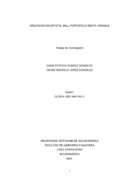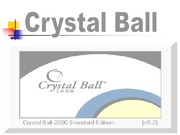Mostrar el registro sencillo del ítem
Aplicación en crystal ball: Portafolio renta variable
| dc.contributor.advisor | Macías Villalba, Gloria Inés | |
| dc.contributor.author | Suárez González, Diana Patricia | |
| dc.contributor.author | López González, Oscar Mauricio | |
| dc.coverage.spatial | Bucaramanga (Santander, Colombia) | spa |
| dc.coverage.temporal | 2004 | spa |
| dc.date.accessioned | 2021-09-21T13:38:00Z | |
| dc.date.available | 2021-09-21T13:38:00Z | |
| dc.date.issued | 2004 | |
| dc.identifier.uri | http://hdl.handle.net/20.500.12749/14368 | |
| dc.description.abstract | A pesar de la eliminación de los supuestos sobre certidumbre total, los enfoques que se trabajan no permiten involucrar la complejidad de la interacción de las muchas variables que tiene que ver con una inversión. Para mencionar algunas de ellas, se pueden pensar en: ¿qué tasa de interés será la adecuada para el futuro? ¿Cuánto valdrá la inversión?, ¿Cuándo comenzará a producir beneficios?, ¿Por cuánto tiempo?, ¿Cómo se comportará el mercado?, ¿Cuáles serán los indicadores económicos en los próximos años?, y como se comportarán los precios en un futuro? Etc. En 1964 David B Hertz propuso un enfoque que permite aproximarse de manera empírica ha este problema tan complejo. Su idea básica no era seguir trabajando con valores esperados o promedios como si fueran eventos ciertos, o sea con probabilidad 1 de ocurrencia. Esta propuesta es conocida como análisis de riego, la cual utiliza simulación. El propósito de este trabajo es rescatar un procedimiento simple propuesto por BLACK (1972), MERTON (1973) y mas tarde en sus textos, por LEVY Y SARNAT (1982), ELTON Y GRUBER (1995) Y BENNINGA (1997). Donde se propone que el portafolio óptimo se puede encontrar maximizando la pendiente de la recta que une el punto de rentabilidad libre de riesgo y la frontera eficiente. Para esto utilizaremos una cartera de valores mobiliarios de la bolsa de valores de Colombia, con la cual se simulará, pronosticará y se analizaran las rentabilidades con la ayuda del software Crystal Ball. | spa |
| dc.description.tableofcontents | INTRODUCCIÓN 1. QUE ES SIMULACIÓN 1 1.1 QUE ES LA SIMULACIÓN DE MONTE CARLO. 2 1.3 PASOS PARA REALIZAR UNA SIMULACIÓN. 3 2. METODOS DE EVALUACIÓN DEL RIESGO PARA PORTAFOLIOS 4 DE INVERSIÓN. 3. VARIABLE ALEATORIA Y DISTRIBUCIÓN DE PROBABILIDAD. 5 3.1 MEDIA Y VARIANZA DE UNA VARIABLE ALEATORIA. 5 3.2 RENDIMIENTO ESPERADO Y RIESGO DE UNA ACCIÓN. 6 4. QUE ES CRYSTAL BALL 7 4.1 COMO CRYSTAL BALL USA LA SIMULACIÓN DE MONTE CARLO. 8 4.2 VENTAJAS DE UTILIZAR CRYSTAL BALL. 9 4.3 DEFINIENDO CELDAS. 10 4.3.1 Definiendo celdas de supuestos. 11 4.4 IDENTIFICANDO TIPO DE DISTRIBUCIÓN 16 4.5 DISTRIBUCION QUE MAS SE AJUSTA. 17 4.5.1 Como trabaja Distribución que mas se ajusta. 17 4.6 DEFINIENDO CELDAS DE DECISIÓN. 21 4.7 DEFINIENDO CELDAS DE PRONÓSTICO. 23 4.8 CORRIENDO LA SIMULACIÓN. 24 4.9 INTERPRETANDO RESULTADOS. 25 5. MODELO 28 5.1 APLICACIÓN DE CRYSTAL BALL 30 5.2 IDENTIFICANDO LA DISTRIBUCIÓN DE DATOS. 31 5.3 ANALISIS DE CORRELACION 34 5.4 CORRIENDO EL MODELO. 37 5.5 RESULTADOS PROPORCIONADOS POR LA SIMULACIÓN. 38 5.5.1 Celda balance final. 38 5.5.2 celda retorno promedio portafolio. 40 CONCLUSIONES. BIBLIOGRAFÍA. | spa |
| dc.format.mimetype | application/pdf | spa |
| dc.language.iso | spa | spa |
| dc.rights.uri | http://creativecommons.org/licenses/by-nc-nd/2.5/co/ | * |
| dc.title | Aplicación en crystal ball: Portafolio renta variable | spa |
| dc.title.translated | Crystal ball application: equity portfolio | spa |
| dc.degree.name | Ingeniero financiero | spa |
| dc.publisher.grantor | Universidad Autónoma de Bucaramanga UNAB | spa |
| dc.rights.local | Abierto (Texto Completo) | spa |
| dc.publisher.faculty | Facultad Economía y Negocios | spa |
| dc.publisher.program | Pregrado Ingeniería Financiera | spa |
| dc.description.degreelevel | Pregrado | spa |
| dc.type.driver | info:eu-repo/semantics/bachelorThesis | |
| dc.type.local | Trabajo de Grado | spa |
| dc.type.coar | http://purl.org/coar/resource_type/c_7a1f | |
| dc.subject.keywords | Financial engineering | spa |
| dc.subject.keywords | Financial analysis | spa |
| dc.subject.keywords | Financial managenment | spa |
| dc.subject.keywords | Simulation | spa |
| dc.subject.keywords | Investment portfolios | spa |
| dc.subject.keywords | Correlation | spa |
| dc.subject.keywords | Cost effectiveness | spa |
| dc.subject.keywords | Risk analysis | spa |
| dc.subject.keywords | Random variable | spa |
| dc.subject.keywords | Investigation | spa |
| dc.subject.keywords | Administration | spa |
| dc.subject.keywords | Simulation methods | spa |
| dc.subject.keywords | Operational games | spa |
| dc.identifier.instname | instname:Universidad Autónoma de Bucaramanga - UNAB | spa |
| dc.identifier.reponame | reponame:Repositorio Institucional UNAB | spa |
| dc.type.hasversion | info:eu-repo/semantics/acceptedVersion | |
| dc.rights.accessrights | info:eu-repo/semantics/openAccess | spa |
| dc.rights.accessrights | http://purl.org/coar/access_right/c_abf2 | spa |
| dc.relation.references | DECISIONEERING, User Manual Crystal Ball, Academic Version 5.2 | spa |
| dc.relation.references | SIMON BENNINGA, Financial Modeling, second edition. Uses excel | spa |
| dc.relation.references | FRANK FABOZZI, FRANCO MODIGIANI, Capital Markets, Third edition. Mc Graw Hill | spa |
| dc.relation.references | ROBERT W. KOLB, Inversiones, Limusa, University of Miami | spa |
| dc.relation.references | JAMES R. EVANS, DAVID L OLSON, Introduction to Simulation and Risk Analysis, Ed. Printice Hall | spa |
| dc.relation.references | DE LARA HARO ALFONSO, Medición y Control de Riesgos Financieros. Ed. Limusa | spa |
| dc.relation.references | JUAN DIEGO GOMEZ, Inversión y Mercado de Capitales, Escuela de Ingeniería de Antioquia | spa |
| dc.relation.references | www.crystalball.com | spa |
| dc.contributor.cvlac | Macías Villalba, Gloria Inés [0000290980] | spa |
| dc.contributor.googlescholar | Macías Villalba, Gloria Inés [_XmXMLUAAAAJ] | spa |
| dc.contributor.orcid | Macías Villalba, Gloria Inés [0000-0001-5897-181X] | spa |
| dc.contributor.researchgate | Macías Villalba, Gloria Inés [Gloria-Macias-Villalba] | spa |
| dc.subject.lemb | Análisis financiero | spa |
| dc.subject.lemb | Ingeniería financiera | spa |
| dc.subject.lemb | Investigación | spa |
| dc.subject.lemb | Gestión financiera | spa |
| dc.subject.lemb | Administración | spa |
| dc.subject.lemb | Métodos de simulación | spa |
| dc.subject.lemb | Juegos operacionales | spa |
| dc.identifier.repourl | repourl:https://repository.unab.edu.co | spa |
| dc.description.abstractenglish | Despite the elimination of the assumptions about total certainty, the approaches that are used do not allow to involve the complexity of the interaction of the many variables that have to do with an investment. To mention some of them, you can think about: what interest rate will be the right one for the future? How much will the investment be worth? When will it start to produce benefits? For how long? How will the market behave? What will the economic indicators be in the coming years? And how prices will behave in the future ? Etc. In 1964 David B Hertz proposed an approach that allows an empirical approach to this complex problem. His basic idea was not to continue working with expected values or averages as if they were true events, that is, with probability 1 of occurrence. This proposal is known as irrigation analysis, which uses simulation. The purpose of this work is to rescue a simple procedure proposed by BLACK (1972), MERTON (1973) and later in their texts, by LEVY AND SARNAT (1982), ELTON AND GRUBER (1995) and BENNINGA (1997). Where it is proposed that the optimal portfolio can be found by maximizing the slope of the line that joins the risk-free profitability point and the efficient frontier. For this we will use a portfolio of securities from the Colombian stock market, with which returns will be simulated, predicted and analyzed with the help of Crystal Ball software. | spa |
| dc.subject.proposal | Simulación | spa |
| dc.subject.proposal | Portafolios de inversión | spa |
| dc.subject.proposal | Correlación | spa |
| dc.subject.proposal | Rentabilidad | spa |
| dc.subject.proposal | Análisis de riesgo | spa |
| dc.subject.proposal | Variable aleatoria | spa |
| dc.type.redcol | http://purl.org/redcol/resource_type/TP | |
| dc.rights.creativecommons | Atribución-NoComercial-SinDerivadas 2.5 Colombia | * |
| dc.coverage.campus | UNAB Campus Bucaramanga | spa |
| dc.description.learningmodality | Modalidad Presencial | spa |
Ficheros en el ítem
Este ítem aparece en la(s) siguiente(s) colección(ones)
-
Ingeniería Financiera [547]



